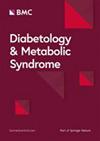Prevalence and factors associated with unhealthy metabolic status according to body mass index: analysis of a national nutritional survey
IF 3.9
3区 医学
Q2 ENDOCRINOLOGY & METABOLISM
引用次数: 0
Abstract
Although obesity substantially influences public health owing to related comorbidities, it has been discovered that the incidence of such issues is not directly related to obesity but to the patient’s unhealthy metabolic status (MUS) independent of the body mass index (BMI). To describe the prevalence of UMS overall and according to BMI and determine the factors associated with it. A cross-sectional analytical study was used based on the analysis of secondary databases called the Life Stage Nutritional Surveillance Survey (VIANEV). Participants were selected in two stages, finally obtaining 885 participants. UMS was defined based on the criteria of the Adult Treatment Panel III used to define metabolic status in a set of 5 parameters, if the subject presented two or more alterations it was considered UMS. Six groups were formed according to BMI: metabolically healthy, average weight (MHNW) and unhealthy (MUNW), metabolically healthy, overweight (MHOW) and unhealthy (MUOW), metabolically healthy, obese (MHO) and unhealthy (MUO).). The total prevalence of UMS was 73.11%, with MUNW, MUOW, and MUO being 47.90%, 80.34%, and 96.44%, respectively. Only 5.31% did not present any metabolic alteration. The multivariable analysis found variations globally according to sex, age, marital status, geographical region, smoking habit, and altitude. A high prevalence of UMS was observed in Peru, indicating that BMI alone is not a sufficient indicator of metabolic status. These findings suggest that strategies should be prioritized to address the growing problem of UMS, considering the particularities of each subpopulation and using a multifaceted approach that addresses modifiable and non-modifiable risk factors.根据体重指数确定不健康代谢状况的发生率和相关因素:全国营养调查分析
虽然肥胖会导致相关的并发症,从而严重影响公众健康,但人们发现,此类问题的发生率与肥胖并无直接关系,而是与患者的不健康代谢状态(MUS)有关,与体重指数(BMI)无关。为了描述 UMS 的总体发病率以及与 BMI 相关的发病率,并确定与之相关的因素。在对名为 "生命阶段营养监测调查(VIANEV)"的二级数据库进行分析的基础上,采用了一项横断面分析研究。研究分两个阶段对参与者进行筛选,最终获得了 885 名参与者。UMS是根据成人治疗小组III的标准定义的,该标准用于定义一组5个参数的代谢状况,如果受试者出现两个或两个以上的变化,则被视为UMS。根据体重指数分为六组:代谢健康、体重一般(MHNW)和不健康(MUNW),代谢健康、超重(MHOW)和不健康(MUOW),代谢健康、肥胖(MHO)和不健康(MUO)。UMS 的总患病率为 73.11%,其中 MUNW、MUOW 和 MUO 分别为 47.90%、80.34% 和 96.44%。只有 5.31% 的人没有出现任何代谢改变。多变量分析发现,性别、年龄、婚姻状况、地理区域、吸烟习惯和海拔高度在全球范围内存在差异。秘鲁的 UMS 患病率较高,这表明仅靠体重指数不足以衡量代谢状况。这些研究结果表明,要解决日益严重的尿毒症问题,应优先制定相关战略,考虑到每个亚人群的特殊性,并采用多方面的方法来解决可改变和不可改变的风险因素。
本文章由计算机程序翻译,如有差异,请以英文原文为准。
求助全文
约1分钟内获得全文
求助全文
来源期刊

Diabetology & Metabolic Syndrome
ENDOCRINOLOGY & METABOLISM-
CiteScore
6.20
自引率
0.00%
发文量
170
审稿时长
7.5 months
期刊介绍:
Diabetology & Metabolic Syndrome publishes articles on all aspects of the pathophysiology of diabetes and metabolic syndrome.
By publishing original material exploring any area of laboratory, animal or clinical research into diabetes and metabolic syndrome, the journal offers a high-visibility forum for new insights and discussions into the issues of importance to the relevant community.
 求助内容:
求助内容: 应助结果提醒方式:
应助结果提醒方式:


